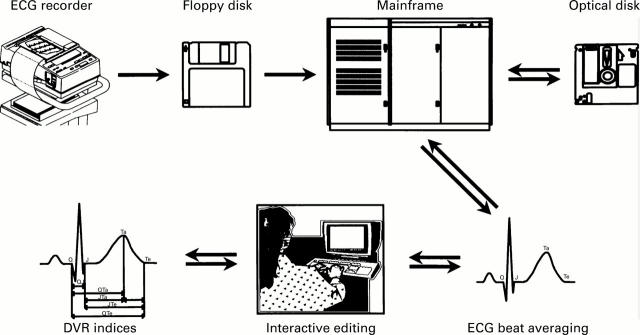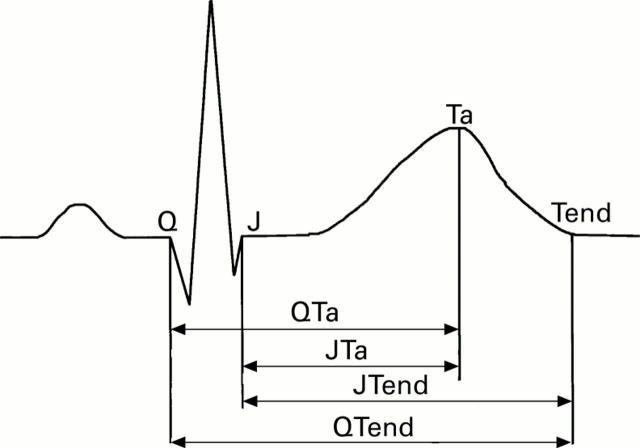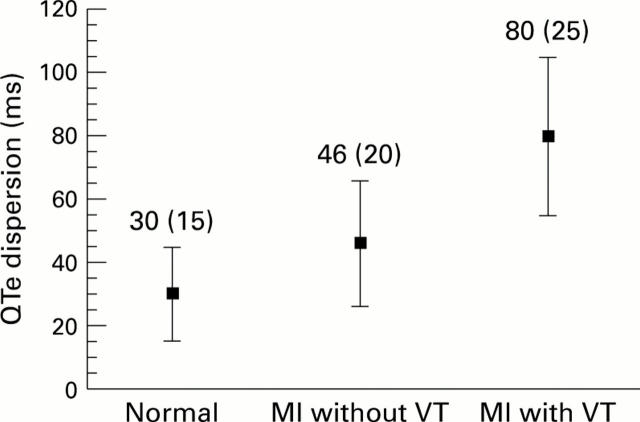Abstract
Objective—To examine whether, in coronary patients after myocardial infarction, the dispersion of ventricular repolarisation measured through QT and JT intervals from a surface electrocardiogram could allow separation of those with ventricular tachyarrhythmias (VT) complicating their myocardial infarct from those without. Design—A retrospective comparative study. Setting—University hospital. Patients—39 patients with myocardial infarction complicated by VT, 300 patients after myocardial infarction without arrhythmic events, and 1000 normal subjects. The myocardial infarction groups were divided into anterior, inferior, and mixed locations. Interventions—A computer algorithm examined an averaged cycle from a 10 second record of 15 simultaneous leads (12 lead ECG + Frank XYZ leads). After interactive editing, four intervals were computed: QTapex, JTapex, QTend, and JTend. For each interval, the dispersion was defined as the difference between the maximum and minimum values across the 15 leads. Results—The mean values of all four dispersion indices were higher in patients with myocardial infarction than in normal subjects (p < 0.01). In the infarct groups, patients with VT had significantly greater mean and centile dispersion values than those without VT. For instance, the 97.5th centile value of QTend was 65 ms in normal individuals, 90 ms in infarct patients without arrhythmia, and 128 ms in those with VT; 70% of the infarct patients who developed serious ventricular arrhythmias had values exceeding the 97.5th centile of the normal group, while only 18% of the infarct patients without arrhythmia had dispersion values above this normal upper limit. Among the infarct patients, nearly half of those (18 of 39) with tachyarrhythmias had dispersion values that exceeded the 97.5th centile of those without arrhythmia. Conclusions—Dispersion of ventricular repolarisation may be a good non-invasive tool for discriminating coronary patients susceptible to VT from those who are at low risk. Keywords: QT dispersion; myocardial infarction; computer analysis; arrhythmias
Full Text
The Full Text of this article is available as a PDF (122.9 KB).
Figure 1 .
Algorithm flow chart showing the data acquisition system and the semiautomatic assessment of ventricular repolarisation.
Figure 2 .
After the validation of the fiducial points on the resulting averaged P-QRS-T complex, four intervals are automatically computed: QTend from QRS onset (Q) to T wave end (Tend), QTa from QRS onset to T wave apex (Ta), JTend from J point to T wave end, and JTa from J point to T wave apex.
Figure 3 .
Comparison of QTe dispersion index values (means; bars = 1 SD) highlighting the differences and the overlap between the three clinical groups: normal subjects, patients with myocardial infarction (MI) without ventricular tachyarrhythmia (VT), and patients with myocardial infarction complicated by arrhythmias.
Selected References
These references are in PubMed. This may not be the complete list of references from this article.
- Battle W. E., Naimi S., Avitall B., Brilla A. H., Banas J. S., Jr, Bete J. M., Levine H. J. Distinctive time course of ventricular vulnerability to fibrillation during and after release of coronary ligation. Am J Cardiol. 1974 Jul;34(1):42–47. doi: 10.1016/0002-9149(74)90091-5. [DOI] [PubMed] [Google Scholar]
- Day C. P., McComb J. M., Campbell R. W. QT dispersion in sinus beats and ventricular extrasystoles in normal hearts. Br Heart J. 1992 Jan;67(1):39–41. doi: 10.1136/hrt.67.1.39. [DOI] [PMC free article] [PubMed] [Google Scholar]
- Day C. P., McComb J. M., Campbell R. W. QT dispersion: an indication of arrhythmia risk in patients with long QT intervals. Br Heart J. 1990 Jun;63(6):342–344. doi: 10.1136/hrt.63.6.342. [DOI] [PMC free article] [PubMed] [Google Scholar]
- Glancy J. M., Garratt C. J., Woods K. L., de Bono D. P. QT dispersion and mortality after myocardial infarction. Lancet. 1995 Apr 15;345(8955):945–948. doi: 10.1016/s0140-6736(95)90697-5. [DOI] [PubMed] [Google Scholar]
- Gough W. B., Mehra R., Restivo M., Zeiler R. H., el-Sherif N. Reentrant ventricular arrhythmias in the late myocardial infarction period in the dog. 13. Correlation of activation and refractory maps. Circ Res. 1985 Sep;57(3):432–442. doi: 10.1161/01.res.57.3.432. [DOI] [PubMed] [Google Scholar]
- Higham P. D., Furniss S. S., Campbell R. W. QT dispersion and components of the QT interval in ischaemia and infarction. Br Heart J. 1995 Jan;73(1):32–36. doi: 10.1136/hrt.73.1.32. [DOI] [PMC free article] [PubMed] [Google Scholar]
- Hii J. T., Wyse D. G., Gillis A. M., Duff H. J., Solylo M. A., Mitchell L. B. Precordial QT interval dispersion as a marker of torsade de pointes. Disparate effects of class Ia antiarrhythmic drugs and amiodarone. Circulation. 1992 Nov;86(5):1376–1382. doi: 10.1161/01.cir.86.5.1376. [DOI] [PubMed] [Google Scholar]
- Kuo C. S., Munakata K., Reddy C. P., Surawicz B. Characteristics and possible mechanism of ventricular arrhythmia dependent on the dispersion of action potential durations. Circulation. 1983 Jun;67(6):1356–1367. doi: 10.1161/01.cir.67.6.1356. [DOI] [PubMed] [Google Scholar]
- Linker N. J., Colonna P., Kekwick C. A., Till J., Camm A. J., Ward D. E. Assessment of QT dispersion in symptomatic patients with congenital long QT syndromes. Am J Cardiol. 1992 Mar 1;69(6):634–638. doi: 10.1016/0002-9149(92)90155-r. [DOI] [PubMed] [Google Scholar]
- Merx W., Yoon M. S., Han J. The role of local disparity in conduction and recovery time on ventricular vulnerability to fibrillation. Am Heart J. 1977 Nov;94(5):603–610. doi: 10.1016/s0002-8703(77)80130-0. [DOI] [PubMed] [Google Scholar]
- Mirvis D. M. Spatial variation of QT intervals in normal persons and patients with acute myocardial infarction. J Am Coll Cardiol. 1985 Mar;5(3):625–631. doi: 10.1016/s0735-1097(85)80387-9. [DOI] [PubMed] [Google Scholar]
- Morgan J. M., Cunningham D., Rowland E. Dispersion of monophasic action potential duration: demonstrable in humans after premature ventricular extrastimulation but not in steady state. J Am Coll Cardiol. 1992 May;19(6):1244–1253. doi: 10.1016/0735-1097(92)90331-g. [DOI] [PubMed] [Google Scholar]
- Perkiömäki J. S., Koistinen M. J., Yli-Mäyry S., Huikuri H. V. Dispersion of QT interval in patients with and without susceptibility to ventricular tachyarrhythmias after previous myocardial infarction. J Am Coll Cardiol. 1995 Jul;26(1):174–179. doi: 10.1016/0735-1097(95)00122-g. [DOI] [PubMed] [Google Scholar]
- Pye M., Quinn A. C., Cobbe S. M. QT interval dispersion: a non-invasive marker of susceptibility to arrhythmia in patients with sustained ventricular arrhythmias? Br Heart J. 1994 Jun;71(6):511–514. doi: 10.1136/hrt.71.6.511. [DOI] [PMC free article] [PubMed] [Google Scholar]
- Schwartz P. J. Idiopathic long QT syndrome: progress and questions. Am Heart J. 1985 Feb;109(2):399–411. doi: 10.1016/0002-8703(85)90626-x. [DOI] [PubMed] [Google Scholar]
- Schwartz P. J., Wolf S. QT interval prolongation as predictor of sudden death in patients with myocardial infarction. Circulation. 1978 Jun;57(6):1074–1077. doi: 10.1161/01.cir.57.6.1074. [DOI] [PubMed] [Google Scholar]
- Schwartz P. J., Wolf S. QT interval prolongation as predictor of sudden death in patients with myocardial infarction. Circulation. 1978 Jun;57(6):1074–1077. doi: 10.1161/01.cir.57.6.1074. [DOI] [PubMed] [Google Scholar]
- Surawicz B. The QT interval and cardiac arrhythmias. Annu Rev Med. 1987;38:81–90. doi: 10.1146/annurev.me.38.020187.000501. [DOI] [PubMed] [Google Scholar]
- Zaidi M., Robert A. R., Fesler R., Derwael C., De Kock M., Brohet C. R. Computer-assisted study of ECG indices of the dispersion of ventricular repolarization. J Electrocardiol. 1996 Jul;29(3):199–211. doi: 10.1016/s0022-0736(96)80083-5. [DOI] [PubMed] [Google Scholar]
- Zareba W., Moss A. J., le Cessie S. Dispersion of ventricular repolarization and arrhythmic cardiac death in coronary artery disease. Am J Cardiol. 1994 Sep 15;74(6):550–553. doi: 10.1016/0002-9149(94)90742-0. [DOI] [PubMed] [Google Scholar]
- van de Loo A., Arendts W., Hohnloser S. H. Variability of QT dispersion measurements in the surface electrocardiogram in patients with acute myocardial infarction and in normal subjects. Am J Cardiol. 1994 Dec 1;74(11):1113–1118. doi: 10.1016/0002-9149(94)90462-6. [DOI] [PubMed] [Google Scholar]





